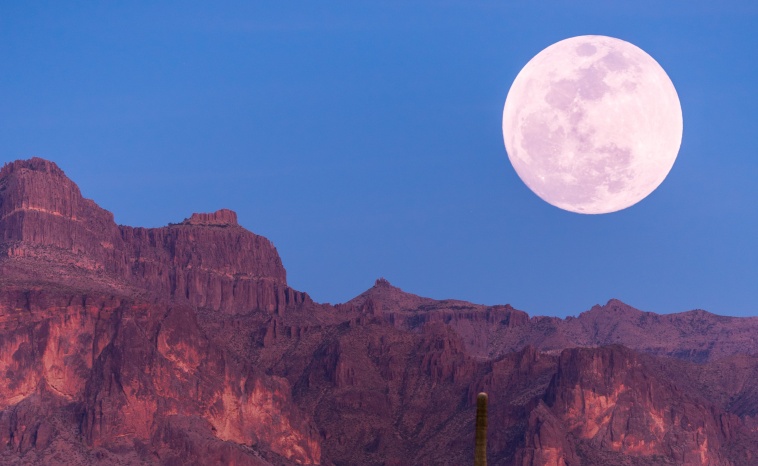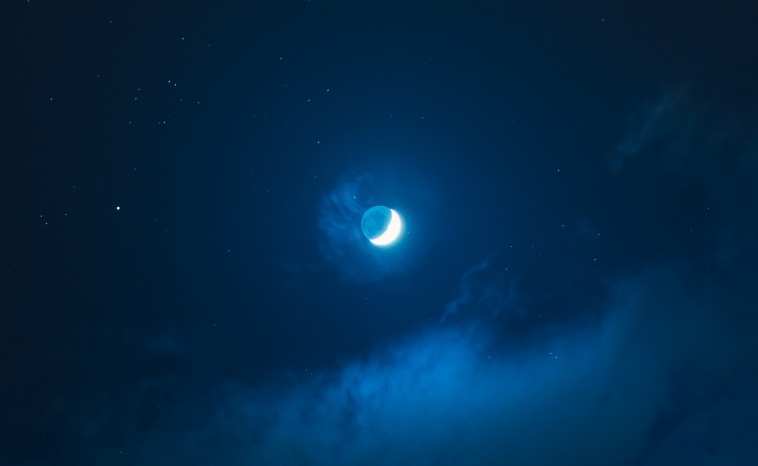What Is a Blue Moon?

It’s a phenomenon that has intrigued astronomers, poets, and culture enthusiasts alike, but what is a blue moon? In this article, we’ll tell you everything you need to know.
Despite its name, a Blue Moon has little to do with the actual colour of the moon! A fascinating and rare occurrence, blue moons have integrated themselves into popular culture courtesy of the saying “once in a blue moon”. This article aims to delve into the intricacies of this fascinating lunar event, its historical background, and its significance in various cultures and scientific fields.
What Is a Blue Moon and Why Is It So Special?

The term historically refers to an unusual phenomenon: the occurrence of a second full moon within a single calendar month. An average lunar cycle is approximately 29.5 days, slightly shorter than most months. This slight discrepancy allows for the rare possibility of two full moons in one month, typically occurring every two and a half to three years.
Contrary to its name, a blue moon is not actually blue in colour. The term is believed to have originated from the old English phrase “belewe moon”, which means “traitor moon”. Over time, however, the phrase morphed into “blue moon” due to language evolution and misinterpretation. The occurrence of one is special due to its rarity, hence the saying “once in a blue moon”, symbolising a rare event that one does not encounter frequently.
Definition of a Blue Moon and its Astronomical Origin
Science presents a blue moon as a testament to the fascinating intricacies of our solar system. Whilst the moon doesn’t change its colour during the event, atmospheric conditions such as dust or smoke particles can sometimes give the moon a bluish appearance, leading to widespread interest and misinterpretation.
On the other hand, while rooted in lunar cycles, the concept has also taken on cultural significance, inspiring countless expressions in literature, music, and art. The celestial event is seen as a symbol of rarity and uniqueness, often evoking a sense of wonder and mystique. Some cultures and traditions attach spiritual or superstitious significance to a blue moon, viewing it as a time of increased power and energy.
As a result, the blue moon serves as a curious intersection of astronomy, culture, and language, encapsulating humanity’s continuing fascination with the cosmos.
Different Types of Blue Moons
There are primarily two types of blue moons – monthly and seasonal. The more common of the two, the monthly blue moon, occurs when there are two full moons within one calendar month. The second full moon of that month is called a blue moon. On the other hand, the less frequent seasonal variety is the third full moon in an astronomical season with four full moons.
The occurrence of blue moons, while predictable, is still considered a special event due to its relative infrequency. A monthly blue moon occurs approximately every 2.5 to 3 years, while a seasonal one takes place about every 2.7 years. These intervals can vary slightly due to the slight discord between the lunar cycle and our calendar system.
The next will take place on Wednesday, 30th August 2023 and will be an extra special one…
The August 2023 Blue Supermoon

The upcoming blue moon in August 2023 is set to be a remarkable astronomical event that skywatchers around the world are excitedly anticipating. A ‘supermoon‘ occurs when the moon reaches its closest approach to Earth in its orbit, resulting in a moon that appears significantly larger and brighter than usual. When this coincides with a blue moon, the spectacle is even more special.
The 30th August 2023 blue supermoon will see the Moon come as close as 222,043 miles from the Earth, making it appear much larger in the night sky. The view will be particularly striking at moonrise and moonset, when it appears larger due to an optical illusion. Of course, the blue supermoon will be visible to the naked eye, but those with binoculars or telescopes can observe with greater detail. As with any celestial event, the visibility and appearance of the moon will depend on local weather conditions and light pollution. However, with the right conditions, observers should be able to see a moon that appears almost surreal in its size and brilliance.
If you miss the event, you’ll unfortunately have to wait a little while to see it again – the next blue supermoon won’t occur until 2037!
The History of the Phrase “Once in a Blue Moon”

The phrase “once in a blue moon” has been in use for over 400 years, with its earliest documented appearance dating back to 1528 in an anti-clerical pamphlet by William Roy and Jerome Barlow. Initially, it connoted absurdity and impossibility, similar to saying “when pigs fly”. However, its meaning evolved over time to reflect rarity instead of absurdity. Notably, in 1821, Pierce Egan’s book, ‘Real Life in London’, referenced the phrase to denote infrequency.
The modern astronomical definitions of ‘blue moon’—both the monthly and seasonal interpretations—only came into general use in the 20th century. The confusion and subsequent redefinition were mainly due to a misunderstanding of the Maine Farmer’s Almanac by amateur astronomer James Hugh Pruett in 1946. He misinterpreted the almanac’s description, leading to the popularisation of the concept of the ‘second full moon in a calendar month’ as a blue moon. The phrase’s history, therefore, is a fascinating tapestry of language evolution, folklore, and a touch of cosmic coincidence.
Fun Facts about Blue Moons
Blue moons hold a certain mystique due to their rarity, but they are not actually blue. However, the moon can appear blue under specific atmospheric conditions, such as when large particles like dust or smoke are present in Earth’s atmosphere. This was the case after the 1883 eruption of Krakatoa in Indonesia, which was so powerful it caused the moon to appear blue and even green in some parts of the world for nearly two years.
Similarly, the moon appeared blue in parts of the United States in 1950 due to smoke from a large forest fire in Alberta, Canada.
How To Observe a Blue Moon

Observing a blue moon requires no special equipment or astronomical knowledge. Check your local moonrise and moonset times to plan your viewing. If possible, find a location away from city lights to minimise light pollution and enable a clearer, more detailed view.
The moon often appears the largest and most spectacular when it is close to the horizon, typically around moonrise and moonset. Even though the effect is primarily psychological, this ‘moon illusion’ enhances the viewing experience. Also, though not necessary, a pair of binoculars or a small telescope can enrich your viewing session, allowing you to explore the moon’s surface features in greater detail.
OSR Star Finder App
While you’re out enjoying the brilliant sight of the upcoming blue supermoon, why not take the time to brush up on some of the other beautiful objects in our night sky? Download the OSR Star Finder App to your iOS or Android device and explore some of the fascinating stars, planets, and constellations in our galactic neighbourhood!

